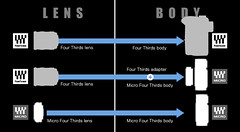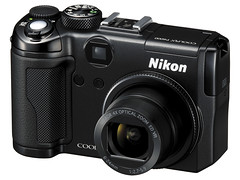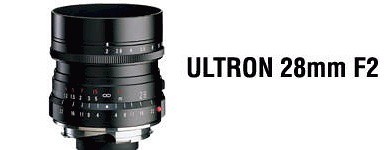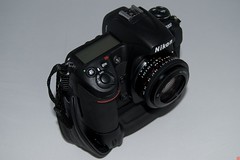Olympus Imaging Corporation (Olympus Imaging) and Matsushita Electric Industrial Co., Ltd. (Panasonic) today announced joint development of technologies and devices for the "Micro Four Thirds System standard," a  new standard that extends the benefits of the Four Thirds System standard for interchangeable lens type digital camera systems by enabling dramatic reductions in size and weight. Under the terms of an agreement between the two companies, they will work jointly toward commercial production of significantly lighter and more compact interchangeable lens type digital camera systems.
new standard that extends the benefits of the Four Thirds System standard for interchangeable lens type digital camera systems by enabling dramatic reductions in size and weight. Under the terms of an agreement between the two companies, they will work jointly toward commercial production of significantly lighter and more compact interchangeable lens type digital camera systems.
The global market for interchangeable lens type digital SLR cameras is growing steadily, but still only accounts for a 7% share of the total digital camera market. Considering the much larger share held by interchangeable lens type SLR camera systems when film was the dominant imaging medium, it seems that there is still ample room for sales growth in the category. But compact digital cameras continue to offer an expanding range of features and performance, and market surveys indicate that customers choose compact models because they find digital SLR cameras to be "big, heavy, and difficult to operate."
Recognizing this market trend, Olympus Imaging and Panasonic have introduced products based on the Four Thirds System standard, and have led the industry in bringing features such as Live View and contrast-detection autofocusing systems to interchangeable lens type digital camera systems.
Now, Olympus Imaging and Panasonic are expanding the potential of the Four Thirds System standard even further, enabling the development of radically more compact and lightweight interchangeable lens type digital camera systems based on the Micro Four Thirds System standard. Together with the existing range of Four Thirds System products, the new range of Micro Four Thirds System products will enable customers to enjoy true interchangeable lens type digital camera system performance.
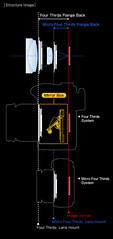
When compared to the Four Thirds System standard, the primary distinguishing characteristics of the Micro Four Thirds System standard are:
Approximately 50% shorter flangeback distance (mount-to-sensor distance)
6mm smaller lens mount outer diameter
Electrical contacts in mount increased from 9 to 11
* Image sensor diagonal dimensions are the same for both Four Thirds System and Micro Four Thirds System standards.
The Micro Four Thirds System enables users to enjoy the high image quality benefits of the Four Thirds System's 4/3-type image sensor in a much more compact camera body, and also take advantage of significantly more compact lenses, particularly in the wide-angle and high-power zoom range. The Four Thirds System offers compact, lightweight performance, and the new Micro Four Thirds System will take this even further by making it possible to develop ultra-compact interchangeable lens type digital camera systems unlike anything seen before. The new Micro Four Thirds System also incorporates a greater number of lens-mount electrical contacts, enabling support for new features and increased system functionality in the future.
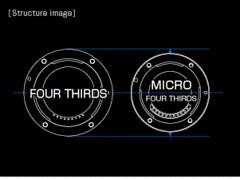
In addition, users will be able to mount their existing Four Thirds System lenses on Micro Four Thirds System bodies via an adapter.
Moving forward, Olympus Imaging and Panasonic will jointly develop relevant technologies and devices for both Four Thirds System and Micro Four Thirds System standards, and will develop and introduce standards-compliant products in accordance with their respective business strategies.
While continuing to develop Four Thirds System interchangeable lens type digital camera system products, Olympus Imaging will also develop a range of Micro Four Thirds System lenses and accessories, and Micro Four Thirds System camera bodies that are even smaller and slimmer than the light, compact, and widely acclaimed Olympus E-410 and E420.
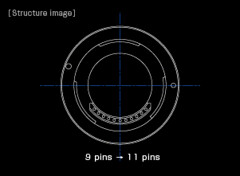
While continuing to develop Four Thirds System interchangeable lens type digital camera system products, Panasonic will also develop a new generation of compact, lightweight, interchangeable lens type digital camera system products, including ultra-portable camera bodies, interchangeable lenses, and related system accessories.
About the Four Thirds System Standard
The Four Thirds System standard defines design and development standards for interchangeable lens type digital camera systems that fully realize the performance potential of digital technology. Four Thirds System cameras utilize a 4/3-type image sensor that delivers the high image quality expected of interchangeable lens type digital camera systems in a form factor that assures outstanding mobility. The Four Thirds System standard is an open standard that enables bodies and lenses produced by participating manufacturers to exchange information and be used interchangeably with one another.
*The company names and product names specified in this release are the trademarks or registered trademarks of each company.
Please be advised that press releases and information posted on this site are current at the time of the original publication date. Please note that they may now be outdated or rendered inaccurate.
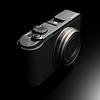 their mouth's shut are strained to the breaking point. Here we see a picture of a Panasonic Micro 4/3's interchangeable lens camera. I believe the image is a computer generated model (albeit, a good one). But whether it escaped from a PanOLeica engineer's laptop or someone's fertile imagination remains to be seen.
their mouth's shut are strained to the breaking point. Here we see a picture of a Panasonic Micro 4/3's interchangeable lens camera. I believe the image is a computer generated model (albeit, a good one). But whether it escaped from a PanOLeica engineer's laptop or someone's fertile imagination remains to be seen. This next image shows the body with the lens removed exposing the 11 electrical contacts (up from 9 contacts in the standard Four Thirds mount). This brings up the mystery of the increase in contacts. For what purpose? Fear not! Our intrepid engineer (artist?) provides us with an answer: a shoe mounted electronic viewfinder (EVF)! Once again, the design specs of Micro Four Thirds are followed. The spec calls for no mirror box in this design. This leads one to believe that the camera would be Live View (on a rather generous rear LCD panel) or some sort of rangefinder affair. A high resolution EVF is an elegant compromise that allows SLR-like framing and maintaining the small size demanded by the spec. This ties in with the increase in electrical contacts between the lens and body.
This next image shows the body with the lens removed exposing the 11 electrical contacts (up from 9 contacts in the standard Four Thirds mount). This brings up the mystery of the increase in contacts. For what purpose? Fear not! Our intrepid engineer (artist?) provides us with an answer: a shoe mounted electronic viewfinder (EVF)! Once again, the design specs of Micro Four Thirds are followed. The spec calls for no mirror box in this design. This leads one to believe that the camera would be Live View (on a rather generous rear LCD panel) or some sort of rangefinder affair. A high resolution EVF is an elegant compromise that allows SLR-like framing and maintaining the small size demanded by the spec. This ties in with the increase in electrical contacts between the lens and body.










